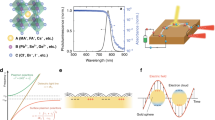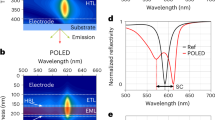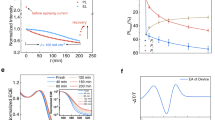Abstract
The field of plasmonics, which studies the resonant interactions of electromagnetic waves and free electrons in solid-state materials1, has yet to be put to large-scale commercial application2 owing to the large amount of loss that usually occurs in plasmonic materials3. Organic light-emitting devices (OLEDs)4,5,6,7 have been incorporated into billions of commercial products because of their good colour saturation, versatile form factor8 and low power consumption9, but could still be improved in terms of efficiency and stability. Although OLEDs incorporating organic phosphors achieve an internal charge-to-light conversion of unity10, their refractive index contrast reduces the observable fraction of photons outside the device to around 25 per cent11,12,13. Further, during OLED operation, a localized buildup of slow-decaying14 triplet excitons and charges15 gradually reduces the brightness of the device in a process called ageing16,17, which can result in ‘burn-in’ effects on the display. Simultaneously improving device efficiency and stability is of paramount importance for OLED technology. Here we demonstrate an OLED that uses the decay rate enhancement18 of a plasmonic system to increase device stability, while maintaining efficiency by incorporating a nanoparticle-based out-coupling scheme to extract energy from the plasmon mode. Using an archetypal phosphorescent emitter, we achieve a two-fold increase in operational stability at the same brightness as a reference conventional device while simultaneously extracting 16 per cent of the energy from the plasmon mode as light. Our approach to increasing OLED stability avoids material-specific designs19,20,21,22 and is applicable to all commercial OLEDs that are currently used for lighting panels, televisions and mobile displays.
This is a preview of subscription content, access via your institution
Access options
Access Nature and 54 other Nature Portfolio journals
Get Nature+, our best-value online-access subscription
$29.99 / 30 days
cancel any time
Subscribe to this journal
Receive 51 print issues and online access
$199.00 per year
only $3.90 per issue
Buy this article
- Purchase on Springer Link
- Instant access to full article PDF
Prices may be subject to local taxes which are calculated during checkout



Similar content being viewed by others
Data availability
The data that support the findings of this study are available from the corresponding author upon request.
References
Maier, S. A. Plasmonics: Fundamentals and Applications (Springer, 2007).
Commercializing plasmonics. Nat. Photon. 9, 477–477 (2015).
Boltasseva, A. & Atwater, H. A. Low-loss plasmonic metamaterials. Science 331, 290–291 (2011).
Tang, C. W. & VanSlyke, S. A. Organic electroluminescent diodes. Appl. Phys. Lett. 51, 913–915 (1987).
Burroughes, J. H. et al. Light-emitting diodes based on conjugated polymers. Nature 347, 539–541 (1990); correction 348, 352 (1990).
Baldo, M. A. et al. Highly efficient phosphorescent emission from organic electroluminescent devices. Nature 395, 151–154 (1998).
Uoyama, H., Goushi, K., Shizu, K., Nomura, H. & Adachi, C. Highly efficient organic light-emitting diodes from delayed fluorescence. Nature 492, 234–238 (2012).
Forrest, S. R. The path to ubiquitous and low-cost organic electronic appliances on plastic. Nature 428, 911–918 (2004).
Pfeiffer, M., Forrest, S. R., Leo, K. & Thompson, M. E. Electrophosphorescent p–i–n organic light-emitting devices for very-high-efficiency flat-panel displays. Adv. Mater. 14, 1633–1636 (2002).
Baldo, M. A., Lamansky, S., Burrows, P. E., Thompson, M. E. & Forrest, S. R. Very high-efficiency green organic light-emitting devices based on electrophosphorescence. Appl. Phys. Lett. 75, 4–6 (1999).
Kim, S.-Y. et al. Organic light-emitting diodes with 30% external quantum efficiency based on a horizontally oriented emitter. Adv. Funct. Mater. 23, 3896–3900 (2013).
Kim, K.-H. et al. Phosphorescent dye-based supramolecules for high-efficiency organic light-emitting diodes. Nat. Commun. 5, 4769 (2014).
Shin, H. et al. Sky-blue phosphorescent OLEDs with 34.1% external quantum efficiency using a low refractive index electron transporting layer. Adv. Mater. 28, 4920–4925 (2016).
Helfrich, W. & Schneider, W. G. Transients of volume-controlled current and of recombination radiation in anthracene. J. Chem. Phys. 44, 2902–2909 (1966).
Giebink, N. C. et al. Intrinsic luminance loss in phosphorescent small-molecule organic light emitting devices due to bimolecular annihilation reactions. J. Appl. Phys. 103, 044509 (2008).
Schaer, M., Nüesch, F., Berner, D., Leo, W. & Zuppiroli, L. Water vapor and oxygen degradation mechanisms in organic light emitting diodes. Adv. Funct. Mater. 11, 116–121 (2001).
Yamamoto, H. et al. Improved initial drop in operational lifetime of blue phosphorescent organic light emitting device fabricated under ultra high vacuum condition. Appl. Phys. Lett. 99, 033301 (2011).
Koenderink, A. F. On the use of Purcell factors for plasmon antennas. Opt. Lett., 35, 4208–4210 (2010).
Zhang, Y., Lee, J. & Forrest, S. R. Tenfold increase in the lifetime of blue phosphorescent organic light-emitting diodes. Nat. Commun. 5, 5008 (2014).
Tsang, D. P.-K., Matsushima, T. & Adachi, C. Operational stability enhancement in organic light-emitting diodes with ultrathin Liq interlayers. Sci. Rep. 6, 22463 (2016); corrigendum 6, 26921 (2016).
Lee, J. et al. Hot excited state management for long-lived blue phosphorescent organic light-emitting diodes. Nat. Commun. 8, 15566 (2017).
Ràfols-Ribé, J. et al. High-performance organic light-emitting diodes comprising ultrastable glass layers. Sci. Adv. 4, eaar8332 (2018).
Okamoto, K. et al. Surface-plasmon-enhanced light emitters based on InGaN quantum wells. Nat. Mater. 3, 601–605 (2004).
Hobson, P. a., Wedge, S., Wasey, J. e., Sage, I. & Barnes, W. L. Surface plasmon mediated emission from organic light-emitting diodes. Adv. Mater. 14, 1393–1396 (2002).
Cesario, J. et al. Coupling localized and extended plasmons to improve the light extraction through metal films. Opt. Express 15, 10533–10539 (2007).
Esteban, R., Teperik, T. V. & Greffet, J. J. Optical patch antennas for single photon emission using surface plasmon resonances. Phys. Rev. Lett. 104, 026802 (2010).
Belacel, C. et al. Controlling spontaneous emission with plasmonic optical patch antennas. Nano Lett. 13, 1516–1521 (2013).
Akselrod, G. M. et al. Probing the mechanisms of large Purcell enhancement in plasmonic nanoantennas. Nat. Photon. 8, 835–840 (2014).
Hoang, T. B. et al. Ultrafast spontaneous emission source using plasmonic nanoantennas. Nat. Commun. 6, 7788 (2015).
Brütting, W., Frischeisen, J., Schmidt, T. D., Scholz, B. J. & Mayr, C. Device efficiency of organic light-emitting diodes: progress by improved light outcoupling. Phys. Status Solidi 210, 44–65 (2013).
Bogdanov, S. I. et al. Ultrabright room-temperature sub-nanosecond emission from single nitrogen-vacancy centers coupled to nanopatch antennas. Nano Lett. 18, 4837–4844 (2018).
Worthing, P. T. & Barnes, W. L. Efficient coupling of surface plasmon polaritons to radiation using a bi-grating. Appl. Phys. Lett. 79, 3035–3037 (2001).
Ha, D.-G. et al. Dominance of exciton lifetime in the stability of phosphorescent dyes. Adv. Opt. Mater. 7, 1901048 (2019).
Im, J. H. et al. Bulk-like Al/Ag bilayer film due to suppression of surface plasmon resonance for high transparent organic light emitting diodes. Org. Electron. 33, 116–120 (2016).
Forrest, S. R., Bradley, D. D. C. & Thompson, M. E. Measuring the efficiency of organic light-emitting devices. Adv. Mater. 15, 1043–1048 (2003).
Hung, L. S., Tang, C. W., Mason, M. G., Raychaudhuri, P. & Madathil, J. Application of an ultrathin LiF/Al bilayer in organic surface-emitting diodes. Appl. Phys. Lett. 78, 544–546 (2001).
Acknowledgements
The authors acknowledge the research staff of Universal Display Corporation (UDC) for discussions and technical assistance.
Author information
Authors and Affiliations
Contributions
M.A.F., M.S.W., V.M.M. and N.J.T. conceived the concepts. M.A.F. and R.S. fabricated the devices and performed the measurements. R.B., M.A.F., V.M.M. and N.J.T. conceptualized the computations and performed the data analysis. M.A.F., R.S., R.B., M.S.W., V.M.M., N.J.T. and J.J.B. contributed to the writing of the manuscript and to discussions of the results.
Corresponding author
Ethics declarations
Competing interests
M.A.F., M.S.W., R.S., N.J.T. and J.J.B. are employed at UDC and have personal financial interests via UDC stock ownership and numerous granted and pending patent applications on phosphorescent emitters and OLEDs. Work by R.B. and V.M.M. on this project was completed as part of their consultancy for UDC; they declare no additional competing interests.
Additional information
Publisher’s note Springer Nature remains neutral with regard to jurisdictional claims in published maps and institutional affiliations.
Extended data figures and tables
Extended Data Fig. 1 Comparison of plasmon NPA resonance on and off a device.
Plot of the TE/BE EL spectrum (solid line) for the plasmon NPA, and diffuse reflectance of the plasmon NPA structure itself (dashed line) measured by ultraviolet–visible spectroscopy. There is good agreement between the two measurements, which shows that the TE/BE spectrum presented in Fig. 3b defines the spectral shape of the plasmon NPA out-coupling.
Extended Data Fig. 2 Decoupling rate enhancement from out-coupling efficiency.
Simulated decay rate enhancement of a vertical dipole (blue lines), a horizontal dipole (red lines) and an isotropic dipole (black lines) in the plasmon device structure compared to the corresponding rates in vacuum with (solid) and without (dashed) Ag nanocubes as a function of wavelength. The solid lines are the average of four simulations. Importantly, the rate enhancement is independent of the inclusion of the Ag nanocube out-coupling structure. Therefore, the rate enhancement originates from the Ag cathode, whereas the out-coupling originates from the NPA formed between the Ag cathode, the gap material and the Ag nanocubes.
Extended Data Fig. 3 Modelled out-coupling efficiencies for several iterations of random nanocube arrays.
a, b, Modelled TE EQE as a function of wavelength for a vertical (a) and a horizontal (b) dipole for four simulations with fill factions of 14%. The TE EQE shown in Fig. 3c contains an equal weight of each curve in order to represent the ensemble behaviour of a large distribution of dipole-to-cube-array orientations in the experimental device. The spectral response and maximum efficiency of a single dipole and cube array is highly dependent on the positioning of the cube array relative to the dipole, which is why an average of four curves is presented in Fig. 3c.
Supplementary information
Supplementary Information
This file contains Supplementary Notes 1–3, including Supplementary Figures 1–19, Supplementary Tables 1–3, and Supplementary References. This file includes additional calculations, device characterization, and modeling data to support the conclusions of the main text.
Rights and permissions
About this article
Cite this article
Fusella, M.A., Saramak, R., Bushati, R. et al. Plasmonic enhancement of stability and brightness in organic light-emitting devices. Nature 585, 379–382 (2020). https://doi.org/10.1038/s41586-020-2684-z
Received:
Accepted:
Published:
Issue Date:
DOI: https://doi.org/10.1038/s41586-020-2684-z
This article is cited by
-
Stable blue phosphorescent organic LEDs that use polariton-enhanced Purcell effects
Nature (2024)
-
Dye-based nanoarchitectonics for the effective bandgap and stability of blue phosphorescent organic light-emitting diodes
Applied Physics A (2024)
-
Optically and radiofrequency-transparent metadevices based on quasi-one-dimensional surface plasmon polariton structures
Nature Electronics (2023)
-
Localised surface plasmon resonance inducing cooperative Jahn–Teller effect for crystal phase-change in a nanocrystal
Nature Communications (2023)
-
Large-scale controllable fabrication of aluminum nanobowls for surface plasmon-enhanced fluorescence
Nano Research (2023)
Comments
By submitting a comment you agree to abide by our Terms and Community Guidelines. If you find something abusive or that does not comply with our terms or guidelines please flag it as inappropriate.



